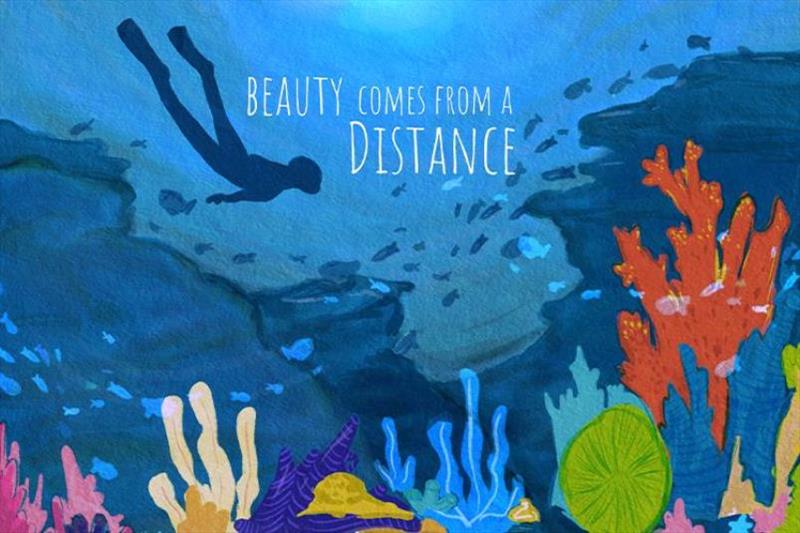
Visual arts can bring us closer to protected marine life, while helping us keep a safe distance
by NOAA Fisheries 4 Mar 2023 18:38 UTC

Eleventh grader Esther W. from the Northern Mariana Islands wowed judges in the 2022 Share the Shore & Sea Youth Art Contest with her digital illustration titled Beauty comes from a distance © NOAA Fisheries
My name is Devon Stapleton, and I recently graduated from University of Hawaii at Manoa with a bachelor of science degree in Marine Biology.
I have spent the last year as a UH STEM Fellow with NOAA Fisheries focusing on education and outreach work. So how was it? In three words: enriching, rewarding, and productive!
Growing up I had struggled under the conventional learning system. I discovered that I learned much better through hands-on teaching methods. And in my pursuit of marine science volunteer and internship opportunities, I've been thrilled to discover pathways that combine my passion for conservation and inclusive learning. I first heard about the NOAA internship through UH's Marine Option Program. I had always wanted to work for NOAA and to learn more about what it would be like to do education and outreach for a larger organization, so I decided to apply.
Helping communities share the Shore & Sea
My first semester in the fellowship was remote, but I was thrilled to develop the very first Share the Shore & Sea Youth Art Contest for NOAA Fisheries' Pacific Islands region. This was a great way to educate K-12 students on protected species in the Pacific and learn about safe viewing distances. The contest allowed me to work on a variety of products, including the contest guidelines and entry system, the contest webpage, and announcements helping spread the word among local educators!
Once the contest opened, the entries trickled in slowly. I remember talking with my mentor about how we hoped to receive enough entries featuring a variety of species across the region to create a calendar. I wondered if the team of scientists, artists, and educators I had recruited to judge the art would have enough art to judge from each age group. But then things started to quickly pick up! We ended up receiving over 250 submissions from all over the Pacific.
The project culminated in the May 2022 Share the Shore week campaign. We posted a series of educational messages about species' distancing requirements along with student artwork. Through this process it was so amazing to see these students' creative work and become inspired about sharing the shore and sea with wildlife!
My favorite part of the internship was seeing the Share the Shore and Sea completed calendar with all of the winners' art work in it. It was so rewarding to be a part of creating this contest and working on it from start to finish.
Check out the 2022 Share the Shore & Sea Contest winning and honorable mention artwork
Putting faces to names with NOAA staff—and rare Pacific corals
This past semester I was able to come into the office at the NOAA Inouye Regional Center once a week and finally get to know the NOAA Fisheries team members I had worked with virtually during the contest. I also got to focus on a new project: developing content for the December Corals Week campaign. I created an infographic focused on how Pacific coral characteristics and threats change with depth. It explains why corals look different with depth, how light and wave energy decreases with depth, and why shallower corals are more often subjected to frequent changes in environmental conditions.
All of the corals on the infographic are extremely rare and are listed as threatened on the Endangered Species Act, so it was interesting to learn about them and share about their importance and threats to the species with a broad audience. My favorite coral that I learned about is Acropora tenella—it's fascinating how certain corals have adapted to living in low-light environments.
The people
My STEM Fellowship has also been a fantastic chance to explore careers and pathways at NOAA. From working with my mentor, Education and Outreach Specialist Celeste Hanley, to interviewing a biologist responsible for recovering an endangered dolphin population, I now have a greater sense of the diverse skill sets that support NOAA's ocean stewardship mission. This is particularly helpful to me as I begin on my own career path post-graduation. It has been inspiring meeting so many people doing such impactful work, helping me learn more about what I want to do in the future.
Explore Internships at NOAA
Are you an undergraduate student interested in gaining hands-on experience in the marine sciences? Learn about internship opportunities at NOAA Fisheries and NOAA.